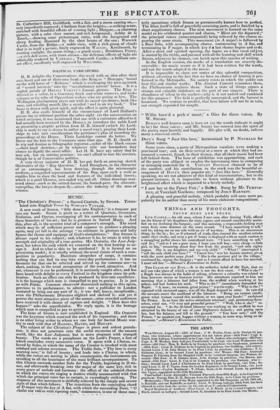PICTORIAL PERIODICALS.
TIIE Fifteenth Part of TURNER'S England and TVales' which completes the First Volume, and the Third Number of the Gallery of Portraits, publishing by the Society for the Diffusion of Useful Knowledge, did i
not reach us n time to be included in our budget last week. The Portraits this month are those of James Watt (the improver of the steam-engine), Marshal Turenne, and the Honourable Robert Boyle ; and the resemblances and engravings are as excellent as those of the first two numbers. It is a great inducement to purchase a work of portraits, to know that the likenesses are true to the original both in
took ...a ehurneter ; in thin respect the present work is unique.
The last part of TURNER'S England is, we think, the best, as regards the subjects chosen, the drawings, and the engravings. Its appearance affords us an opportunity of noticing the Fourteenth Part, which we had accidentally passed over at the time of its publication ; and also of ac- counting for the circumstance of these views not having been appreciated as they deserve to be ; and in so doing, we shall perhaps give "a reason for the faith that is in us" as respects the genius of TURNER. To say the truth, TURNER'S works are not always understood, especially in prints, where the magic of his colouring is lost, and the eccentricities of his style are therefore more apparent. TURNER cannot content himself with a bare delineation of a country town or a particular building. He some- times makes the principal objects of secondary importance, and subser- vient to the pictorial effect; his object being to make a rich and beauti- ful picture. Those, therefore, who prefer a view in proportion to its matter-of-fact qualities and local accuracy of resemblance, are dissatis- fied with the licence which he takes in depicting some well-known scene, from a new and perhaps impossible point of view. They naturally prefer, therefore, the plain and simple views of Attom, which we noticed a week or two ago, to all the splendours of TURNER'S pencil.
It may seem a paradox to say, that the more refined the feeling of the artist, even though his skill be preeminent, the more his works require an allowance for the imperfections of the art. But it is nevertheless true ; because, the more recondite the combinations of light and colour, the more rare and transient the effects introduced, the greater is the difficulty, and the greater the nicety of eye and band required to imitate them ; and the less obvious will be their beauties to the general eye. Many persons, too, who are unaccustomed to look attentively at works of art, are apt to appreciate a picture less for the perfection of the imitation of nature, than on account of the object represented. In their rude estimate also of the merit of the artist or his work, they pre- fer the coarse and vulgar copy, on account of its glaring features of resemblance. The delicate and subtle indications of the slighter, perhaps, but more perfect representation—its details, rich in fine perceptions and original combinations of effect, producing an ag- gregate picture of a scene that affects the sense like actual nature— are lost to their eyes. Yet it is this power to fix on the canvass fleeting forms and evanescent hues, that constitutes the charm of art and the triumph of genius. The permanence of the pictorial representation makes up for its imperfections. We admire the work almost in proportion to the deficiencies which it betrays in the re- sources of the art ; for none but a master who can delight us by the exercise of transcendent skill in the delineation of forms and objects for which his art is sufficient, will venture to approach those difficulties where its insufficiency is apparent. This, we think, is the secret of TURNER'S works not having their due effect upon superficial ob- servers: at the same time, there are many who pay his genius the homage of lip admiration, for fashion's sake, and affect the taste they do not possess; while there are as many whose want of acquaintance with the language of painting renders them less sensible of the brit. Nancy of the original pictures, seen only through the necessarily imper- fect medium of the engraver's translation. The views in the Fourteenthend Fifteenth Numbers are as follows St. Catherine's Hill, Guildford, with a fair, and a storm coming on,— very imperfectly engraved ; Chatham from the heights,—a striking scene, enriched with beautiful effects of evening light ; Margate,—a charming picture, • with a calm clear. sunset, and rich foreground; Ashby de la Zouch,—showing some picturesque ruins, with the foreground and sheep feeding, illumined by the slant beams of the sun ; Warwick Castle, from the Bridge,—a noble view, with a rich group of clouds that is in itself a picture, finely engraved by WALLis ; Kenilworth, by evening sunlight, the moon rising,—a grand scene ; Brinkburn Priory, —a rich dell scene, with trout-stream— the delicious effects of light are admirably rendered by VARRALL ; .fumworth Castle,—a brilliant sun. set effect, excellently well engraved by WILLMORE.



























 Previous page
Previous page